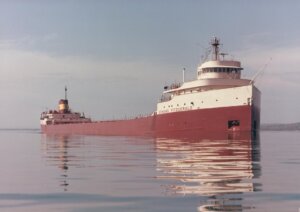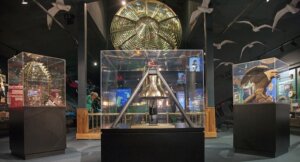Echoes of the Deep:
Echoes of the Deep:
Commemorating the Legacy of the Edmund Fitzgerald
Gurman Pannu
Port2Port - 2025
The Great Lakes have been vital to North American shipping for centuries, and they are known for their "difficult, hazardous, and dangerous" reputation.1 The waves produced by the lakes are different from those of the ocean, with a much shorter frequency and unpredictable weather. The waves and storms combined can be as dangerous as the ocean2 as they are the single largest cause of shipwrecks in the Great Lakes.3

Figure 1: SS. Edmund Fitzgerald on the St. Marys River, Michigan.
One of the most tragic events in Great Lakes maritime history is the sinking of the Edmund Fitzgerald in 1975, pictured in Figure 1.4 On November 9, 1975, the "Fitz" carrying 26,000 tons of taconite pellets, left Superior, Wisconsin, bound for Detroit.5 Soon after departing, the National Weather Service issued a gale warning for Lake Superior. November storms were notorious on the Great Lakes, and though severe weather was common, this storm, "the November Witch," would prove deadly.6
The Fitzgerald was accompanied by the Arthur M. Anderson, another freighter captained by Bernie Cooper. The following events present the heroic journey of the Anderson, reflecting how humans should respond to crisis 'with sacrifice, courage, and faith.'7 As the two ships pressed forward, conditions deteriorated rapidly. Captain Ernest McSorley of the Fitzgerald soon reported damage, including lost vents and a dangerous list.8 Still, he remained calm and asked Cooper to stay nearby until they reached Whitefish Bay. By late afternoon, the Fitzgerald lost connection to the Whitefish Point radio beacon, and at 7:10 p.m., McSorley sent his final message: "We are holding our own." Just ten minutes later, the ship vanished from radar, disappearing into the icy depths of Lake Superior with all 29 crew members.9
The sinking of the Edmund Fitzgerald shocked the maritime community, prompting investigations into what caused the disaster. The U.S. Coast Guard concluded there was flooding mostly likely caused by unsecured deck hatch covers,10while the National Transportation Safety Board suggested that rogue waves might have damaged the hatch covers, leading to rapid flooding.11 Regardless of the exact cause and the various speculations, the tragedy led to significant changes in shipping regulations. For example, new safety measures were introduced, including mandatory survival suits for crews, improved depth finders and positioning systems, and more frequent vessel inspections. These regulations were designed to prevent similar tragedies from occurring in the future and to improve the overall safety of ships navigating the Great Lakes.12
Almost 50 years later, the story of the Edmund Fitzgerald endures as one of the most well-known shipwrecks in Great Lakes history. The story of the Fitzgerald taps into a larger human tradition as it can help communities make sense of loss and tragedy. The ongoing commemoration of the Edmund Fitzgerald serves a dual purpose: it honors the memory of the lost crew members, keeping the story alive and ensures that the hard lessons learned from this disaster continue to influence shipping practices today.13 The ship's 200 lb. bronze bell, pictured in figure 2, recovered on July 4, 1995, now resides in the Great Lakes Shipwreck Museum as a tribute to those who perished.14

Figure 2: *Fitzgerald*'s 200 lb. bronze bell.
The sinking of the Edmund Fitzgerald remains a defining moment in the history of Great Lakes shipping. While the exact cause of the tragedy is still debated, the event led to lasting changes in maritime safety, and its memory continues to resonate. The legacy of the Fitzgerald reminds us of the power of the Great Lakes, the bravery of those who navigate them, and the importance of learning from the past to ensure safer futures.
-
Pierre Camu, "Shipwrecks, Collisions and Accidents in St. Lawrence/Great Lakes Waterway, 1848-1900," The Northern Mariner 6, no. 2 (1996), 57. ↩
-
Author Unknown, Biggest Waves I've Ever Seen: Angling Company Owner on Sault Storm, CTV News (Dec. 16. 2021). ↩
-
Camu, "Shipwrecks, Collisions and Accidents," 57. ↩
-
Figure 1: [SS. Edmund Fitzgerald on the St. Mary's River, Michigan], photograph, Wisconsin Historical Society, n.d. ↩
-
James B. King, Francis H. McAdams and Elwood T. Driver, Marine Accident Report, National Transportation Safety Board (1978). ↩
-
Jeffery B. Halverson, "Dark Ocean Maritime Disasters in the Modern Age," Weatherwise, 74 no.1 (2020),15. ↩
-
Jacqueline Justice, "Classical Tragedy and the Wreck of the Edmund Fitzgerald: Why the Legend Lives On," The Journal of American Culture 36 no.2 (2013), 95. ↩
-
John Myers, "Edmund Fitzgerald Sinking Still Leads Great Lakes Lore," Tribune Business News (Washington: Tribune Content Agency LLC, 2010). ↩
-
Myers, "Edmund Fitzgerald Sinking." ↩
-
Author Unknown, S.S Edmund Fitzgerald Sinking in Lake Superior on 10 November 1975 with Loss of Life, U.S. Coast Guard, (1977), 93. ↩
-
Author Unknown, "S.S Edmund Fitzgerald Sinking," 27. ↩
-
Author Unknown, "S.S Edmund Fitzgerald Sinking," 36-39. ↩
-
John R. Beck, "History and Memory: Commemorations for SS Edmund Fitzgerald," International Journal of Maritime History 24, no. 1 (2012), 204 ↩
-
Figure 2: [Fitzgerald's 200 lb. bronze bell], photograph, Great Lakes Shipwreck Museum, n.d. ↩

